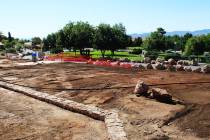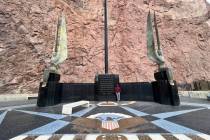Project to prevent flooding in Bootleg Canyon
With rainfall that makes its way swiftly down the mountains, creating a host of problems in its wake, the Boulder City Public Works department is working with the Regional Flood Control District on a project that will prevent flooding in Bootleg Canyon.
Construction on an upgraded detention basin is expected to last until the end of the year. When it’s finished, it will limit the amount of floodwaters that come down the mountain near the industrial businesses on Yucca Street, according to Public Works Director Scott Hansen.
Hansen said the construction will cause traffic problems on Yucca near the animal shelter, and advised drivers to take Canyon Road for easier access. The project was something that needed to be done, he said, especially since the waters come so close to several businesses.
“When the floodwaters and rain come over the mountain, it always creates flooding downstream,” Hansen said. “It all comes off really fast when it comes rushing down.”
Because of the mountainous terrain around the area, the new basin will store roughly 90 percent of the rainfall it receives. The project had been in the works for several years, according to Hansen, and with help from the Regional Flood Control District, construction can finally get underway.
According to Kelsey Hand of the Regional Flood Control District, the detention basin will hold approximately 95 acre-feet of water. One acre-foot holds 325,851 gallons of water.
The project will cost about $660,000, Hansen said, though all of the funding will be provided by the Flood Control District.
Hand said Boulder City receives about 2 percent of the the district’s annual funding, equating to approximately $1 million per year. However, Hand said the amount of projects discussed are based on need, with several factors taken into consideration.
“We have a criteria to prioritize funding,” she said. “It’s based on population affected by the project, land value affected, and what else would be affected if the area flooded.”
Hand said public perception also plays a role into determining what projects get assistance with funding, as well as emergency access and public inconvenience during construction.
The Flood Control District has spent approximately $27 million on Boulder City projects since it opened in 1985, Hand said. But even after projects are completed, the district continues to spend money to keep them updated. According to Hand, the district has spent about $800,000 in the past five years maintaining projects in Boulder City.
Hansen said the city is working on another flood control project on Buchanan Boulevard that will begin in the next few months. That project is expected to cost about $4 million, with the Flood Control District providing the funding for that as well.
That project is expected to have a substantial impact on traffic.











